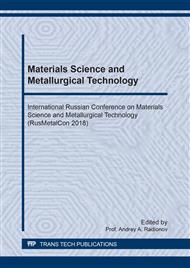[1]
A.B. Naizabekov, Scientific and technological bases of alternating deformation influence on the increase of forging efficiency, Gylym, Almaty, (2006).
Google Scholar
[2]
A.L. Vorontsov, Plastic flow during upsetting of hollow billets, Forging and Stamping Production. Material Working by Pressure, 1 (2007) 3-8.
Google Scholar
[3]
K. Essa, I. Kacmarcik, P. Hartley, M. Plancak, D. Vilotic, Upsetting of bi-metallic ring billets, Journal of Materials Processing Technology, 212 (2012) 817-824.
DOI: 10.1016/j.jmatprotec.2011.11.005
Google Scholar
[4]
A. Krishnaiah, Uday Chakkingal, P. Venugopal, Production of ultrafine grain sizes in aluminium sheets by severe plastic deformation using the technique of groove pressing, Scripta Materialia, 52 (2005) 1229-1233.
DOI: 10.1016/j.scriptamat.2005.03.001
Google Scholar
[5]
Q. Yang, A.K. Ghosh, Production of ultrafine-grain microstructure in Mg alloy by alternate biaxial reverse corrugation, Acta Materialia, 54 (2006) 5147–5158.
DOI: 10.1016/j.actamat.2006.06.045
Google Scholar
[6]
E. Hosseini, M. Kazeminezhad, A new microstructural model based on dislocation generation and consumption mechanisms through severe plastic deformation, Computational Materials Science, 50 (2011) 1123–1135.
DOI: 10.1016/j.commatsci.2010.11.012
Google Scholar
[7]
B.M. Shlyakman, L.P. Belova, Improvement of the forging equipment and the broad plates forging process, Forging and Stamping Production. Material Working by Pressure, 6 (1990) 9-10.
Google Scholar
[8]
V.V. Kukhar', The influence of the convex radius of oblong upsetting plates on the strain state and the degree of use of the plasticity reserve during upsetting, Material Working by Pressure: proc., DMMA, Kramatorsk, 1 (2012) 105–111.
Google Scholar
[9]
V.A. Tyurin, Innovative forging technologies with macro-shears implementation, Forging and Stamping Production. Material Working by Pressure, 11 (2007) 15–20.
Google Scholar
[10]
O.E. Markov, Research of technological process of forging of large forgings by wedge dies, Izvestiya. Ferrous Metallurgy, 12 (2012) 24-27.
DOI: 10.17073/0368-0797-2012-12-24-27
Google Scholar
[11]
A.B. Naizabekov, Zh.A. Ashkeev, Strain state of the billets in dies with trapezoidal ledge and hollow, Izvestiya. Ferrous Metallurgy, 4 (1998) 13-14.
Google Scholar
[12]
S. Sepahi-Boroujenia, A. Sepahi-Boroujeni, Improvements in microstructure and mechanical properties of AZ80 magnesium alloy by means of an efficient novel severe plastic deformation process, Journal of Manufacturing Processes, 24 (2016) 71–77.
DOI: 10.1016/j.jmapro.2016.07.007
Google Scholar
[13]
Naoya Kamikawa, Tadashi Furuhara, Accumulative channel-die compression bonding (ACCB): A new severe plastic deformation process to produce bulk nanostructured metals, Journal of Materials Processing Technology, 213 (2013) 1412-1418.
DOI: 10.1016/j.jmatprotec.2013.02.016
Google Scholar
[14]
M. Shahbaz, N. Pardis, R. Ebrahimi, B. Talebanpour, A novel single pass severe plastic deformation technique: Vortex extrusion, Materials Science and Engineering, A 530 (2011) 469-472.
DOI: 10.1016/j.msea.2011.09.114
Google Scholar
[15]
M.I. Latypov, I.V. Alexandrov, Y.E. Beygelzimer, S. Lee, H.S. Kim, Finite element analysis of plastic deformation in twist extrusion, Computational Materials Science, 60 (2012) 194-200.
DOI: 10.1016/j.commatsci.2012.03.035
Google Scholar
[16]
Chengpeng Wanga, Fuguo Li, Qinghua Li, Lei Wang, Numerical and experimental studies of pure copper processed by a new severe plastic deformation method, Materials Science and Engineering, A 548 (2012) 19-26.
DOI: 10.1016/j.msea.2012.03.055
Google Scholar
[17]
M. Ebrahimi, F. Djavanroodi, Experimental and numerical analyses of pure copper during ECFE process as a novel severe plastic deformation method, Progress in Natural Science: Materials International, 25 (2014) 68-74.
DOI: 10.1016/j.pnsc.2014.01.013
Google Scholar
[18]
L. Zaharia, R. Comaneci, R. Chelariu, D. Luca, A new severe plastic deformation method by repetitive extrusion and upsetting, Materials Science and Engineering, A 595 (2014) 135-142.
DOI: 10.1016/j.msea.2013.12.006
Google Scholar
[19]
V.K. Vorontsov, A.V. Kotelkin, A.B. Naizabekov et al., The method of forgings manufacturing and equipment for its implementation, Cert. of auth. USSR №1409394, Bul. 26,(1988).
Google Scholar
[20]
A.B. Naizabekov, S.N. Lezhnev, E.A. Panin, A.O. Tolkushkin, Tool for forgings production, Innovative patent of Rep. of Kaz. РК №30420, Bul. 10, (2015).
Google Scholar
[21]
A.P Gulyaev, Materials science, Metallurgy, Moscow, (1978).
Google Scholar


